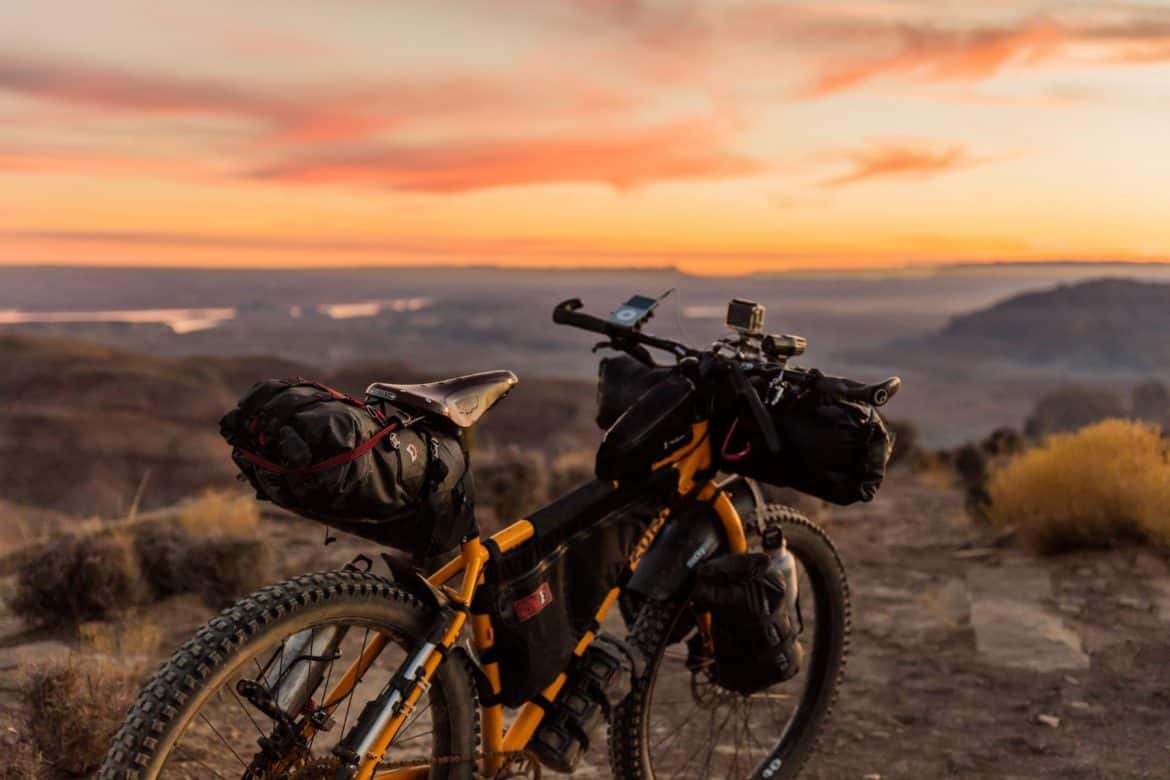If you are not familiar with what bikepacking is – imagine backpacking, but having far more autonomy and independence. Not being dependent on train or bus timetables and seeing the world from a different perspective. If you thought that backpacking was the ultimate travel experience, then you need to take it one step further.
Bikepacking that takes the best elements of cycling, backpacking and camping and puts it all together in one incredible travel experience.
On your bike, you will get really off of the beaten tourist path and forge your own so you can gain a totally unique perspective on the places you’re exploring. You will also not only watch the landscape fly past you through the window but you will become a part of it. The slow pace of a bike lets you notice every little details that you pass. You can stop whenever you want. See an interesting rock formation? Let’s check it out. At the same time your bike is still fast enough to cover some distance and do a real trip. You will also work on your stamina and health as biking is one of the healthier sports that you can do, just avoid the high traffic roads and pollution.
If this sounds like the adventure of a lifetime, then read on as this guide will get you started. Here are three tips to help you understand what you need to know and take with you on your first bikepacking trip.
1 – Pack light
If you think you are already a minimalist when it comes to packing for a trip, think again. You need to pack light for your trip and then strip it down and pack it again but even lighter.
Let’s start with your camping gear. You should go with the absolute basics as much of your gear is going to be on the bike itself and not in a backpack. If you put a backpack on it can affect how you ride and can even cause a lot of spills. Instead, make sure to get the right gear to strap all of these bags to the bike. This will create a lower center of gravity and make it easier to ride long distances.
To really slim down your bags, forget about bringing a tent along, especially if your tent it not the most expensive ultra light and super small tent out there. Instead have a lightweight tarp that can be folded up neatly and tied down to some tree branches with stainless steal spring clips.
Then, you can use some more of the space you save for other essentials like a mat to sleep on and more room for your cooking equipment. You’re also going to need to pack tools and spares for your bike when you need to change a tube or fix your chain. These problems are inevitable so make sure you plan ahead with the right kit to handle these fixes.
Good bikepacking bags should be waterproof and you should be able to attach them to the bike without worrying that they will come loose and fall of, even if the road gets super rough. Once you have the bags and you fill them with sleeping, cooking and quick repair essentials, you will see how much space you have left for other things.
2 – Have the right bike
Your bike is going to make or break your trip. If you have the wrong bike it won’t handle the terrain well and will be a slog getting from point A to point B. The right bike will be one in which you rarely give it a thought and you are able to actually enjoy the journey and not just the destinations.
The best kind is a hybrid between mountain bike and city bike. You want it to be able to handle the different terrain you will encounter. For instance, a lot of your ride is going to be on city roads as you are likely to be looking to see the typical landmarks in the area. Avoid a mountain bike because it is hard to ride on these smooth and flat surfaces. The knobby tires will make it unpleasant and you won’t get much glide in making you pedal more and use more energy to move.
You’re also going to face a lot of bike trails with loose gravel. In this case you need tires that will help grip the surface so you aren’t going to slide. Lastly, you will encounter uneven ground, mud puddles and even rocks on your path. This is when having tires that are not smooth for city riding will help you in addition to good suspension.
It’s good to know in advance what kind of roads/trails you will be riding most of the time and also, what kind of trails you prefer to ride. If you want to make good time and cover lots of distance then you would stick to straight paved roads, if you want to avoid traffic and go as deep in nature as possible then you can look for backcountry dirt roads. A more road oriented bike is better in a first case and more mtb oriented bike is better in second. I would not suggest a full on mountain bike (full suspension) except if you are a mountain biker and you also want to ride mtb trails during your trip.
No matter which style bike you plan to buy, make sure it is one that can handle the rigors of some heavy use while also being low maintenance.
3 – Plan well
Going with the flow is not a good idea when bikepacking. You should have a well planned route that is well researched. Make sure to have a daily limit of mileage so you can plan your stops around areas where you can camp out. The last thing you want is to have to push on to then set up a camp when you are already exhausted.
Plan to cover a minimum of 20 miles per day and a maximum of 40. This will give you the time to cover a lot of ground to get to the next destination while also allowing you to enjoy where you are before moving along too quickly. Exception to this is if the place where you are backpacking allows you to sleep just anywhere and it is also safe to do so. Local farmers will usually gladly let you sleep on their property or even in the barn or something, if you ask them.
The most important part is to plan for the season especially since you will be camping. Avoid the rainy season in the area where you plan to go and check the weather.

